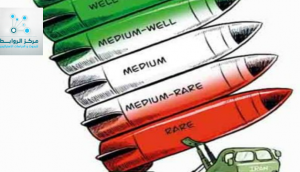BY :Shatha kalel
Introduction:
The recent Israeli airstrikes on military sites in Iran have drawn widespread condemnation from key Gulf states, with Saudi Arabia, the UAE, Oman, and Kuwait calling for restraint and adherence to international laws. Although Iranian air defenses responded by intercepting incoming missiles in central Tehran, the strikes notably avoided Iran’s critical oil and nuclear infrastructure, suggesting Israel’s intent to limit escalation. This carefully calibrated response is a signal not only of Israel’s strategic intentions but also reflects the broader dynamics of Middle Eastern politics and security concerns.
The event has implications not only for regional stability but also for the economies and political alliances shaping the region. Given the rising tensions, this article provides an analysis of the economic and political impacts, expectations, and likely future scenarios in the wake of the strikes.
1. Political Analysis: Regional Diplomacy and Power Dynamics
1.1. Israel’s Strategic Calculus:
Israel’s choice to target military facilities rather than more sensitive infrastructure indicates an approach aimed at containment rather than provocation. According to Israeli researcher Benny Sabti, this measured response likely signals Israel’s interest in de-escalation, sending a message to Iran that further conflict is avoidable if military posturing remains limited. Israel appears to be reinforcing its deterrence without triggering a large-scale conflict that could draw in other regional players and escalate international involvement.
1.2. Reactions from the Gulf States:
The unified condemnation from Gulf countries—including Saudi Arabia, the UAE, Oman, and Kuwait—underscores the growing discontent among regional players over the escalation of military activities. Saudi Arabia’s response highlighted its commitment to sovereignty and peace, stressing the risks posed by further escalation in the region. The UAE and Oman, both of which maintain significant diplomatic relationships with Iran, emphasized the need for peaceful, diplomatic conflict resolution. These statements reflect the Gulf states’ strategic interest in containing any confrontation that could destabilize the Gulf, disrupt trade routes, and harm economic partnerships.
1.3. Diplomatic Channels and Mediation Opportunities:
Oman’s strong diplomatic ties with both Israel and Iran position it as a potential intermediary that could facilitate backchannel talks to prevent further escalation. If tensions do rise, Oman, alongside the UAE, could play a crucial role in rallying regional actors toward a diplomatic resolution, particularly given the wider geopolitical tensions that an intensifying Israeli-Iranian conflict could fuel.
2. Economic Analysis: Impacts and Expectations
2.1. Oil Markets and Energy Security:
While the strikes did not target Iran’s oil facilities, even limited confrontations can create instability in the oil-rich Gulf, causing uncertainty in global oil markets. A disruption to Iran’s oil exports could drive oil prices higher, directly affecting economies that rely on stable oil prices, such as the Gulf states, which benefit from maintaining low volatility in energy markets. If the conflict were to escalate and threaten Iran’s oil infrastructure, we could expect oil prices to spike, impacting both regional and international markets.
2.2. Trade and Investment Concerns:
Instability in the Middle East generally deters foreign investment, as investors are wary of the risks associated with volatile security environments. Given that the UAE and Saudi Arabia are positioning themselves as regional trade and investment hubs, sustained tensions between Israel and Iran could hamper investor confidence. Moreover, the potential risk of conflict across key shipping routes, particularly the Strait of Hormuz, could further strain trade activities, resulting in higher costs and delays.
2.3. Defense Spending and Economic Diversification:
If this incident prompts a prolonged period of tension, Gulf states may further increase their defense spending to secure borders and deter regional aggression. This could strain budgets already allocated toward economic diversification initiatives, as resources shift back toward security investments. Balancing defense with diversification goals will be critical for regional stability and economic resilience moving forward.
3. Expectations and Possible Scenarios
Scenario 1: De-escalation and Diplomacy
The most favorable outcome would involve immediate diplomatic efforts by Oman or other neutral states, aiming to mediate between Iran and Israel to reduce the potential for further strikes. In this scenario, the Gulf states may collectively encourage Iran and Israel to return to diplomacy and refrain from retaliatory actions. This could stabilize oil prices and maintain investor confidence, particularly if Iran and Israel adopt a mutual agreement to limit military activities.
Scenario 2: Controlled Escalation with Regional Mediation
Should tensions persist, there is a possibility of limited, controlled confrontations as Israel continues to enforce its deterrence policy. Saudi Arabia, the UAE, and Kuwait might actively work alongside Oman to contain any escalation, likely calling for support from the United Nations and major powers like the U.S. to prevent further military engagement. In this scenario, economic uncertainty may increase moderately but would likely stabilize if diplomatic pressure proves effective in curbing conflict expansion.
Scenario 3: Escalation Leading to Energy Market Disruption
In the worst-case scenario, sustained conflict could result in strikes on oil and nuclear sites, impacting global oil supplies and sparking significant market disruption. Such an escalation would draw condemnation from international bodies and prompt Gulf countries to increase diplomatic intervention to avoid economic downturns. Prolonged conflict could significantly impact regional stability, lead to heightened defense spending, and put a strain on economies reliant on steady oil production and trade.
Conclusion
The recent Israeli airstrikes on Iranian military sites highlight the region’s complex balance of power, with each state weighing security concerns against the economic costs of conflict. The strong condemnations from Gulf states signal a collective desire to curb the cycle of violence and prioritize regional stability. However, economic impacts remain contingent on the trajectory of these tensions. As regional players, particularly Oman, navigate diplomatic pathways, the possibility of a mediated de-escalation remains within reach, albeit fragile. Key stakeholders, therefore, will continue to watch developments closely, knowing that the future of Middle Eastern stability hinges on each party’s willingness to negotiate rather than retaliate.
Economic Unit/North America Office
Al Rawabet Center for Research and Strategic Studies

